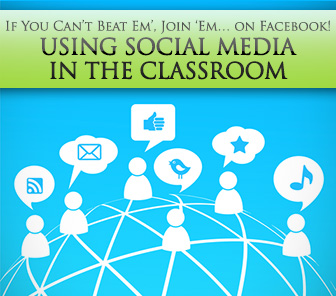
It happens more times than I can count. “Student X, please put away your cell phone.” “Student Y, please stay on task.” “Student Z, please stop checking Facebook and work on your timed reading.”
In the daily battle to keep students’ attention in class, social media is a very present foe. It distracts. It deters. It hinders. But, it doesn’t have to be this way. The very tools that occupy 60% of our students’ days and thoughts can be used to our advantage. They can be a secret weapon for us because (most of) our students are familiar with it. Here are some tips of going with the flow and making social media work for the classroom.

Why use social media?
For starters, Facebook is stomping grounds for many of our students. Many of our students may be far from their home country, and they see Facebook as their connection to back home. It’s how they bond with friends; it’s how they share cute cat videos that make them laugh. It makes them feel comfortable, and being comfortable is a prime place for language learning to take place. With their feelings of insecurity lowered, they will be more willing to produce more language.
-
1
Website Literacy
The Internet is here to stay. With increasingly paperless systems, we need to teach our students to not only be literate in English, but be web-literate as well. They need to learn how to scan websites, how to look for main ideas on a crowded web page, how to navigate a menu, and even how to recognize ad scams and potential virus attacks. Our students are going to be citizens of a digital world, and if the only English we teach them comes from paper, we are doing them a disservice.
-
2
Teaches “real” language
The best part about Facebook, Twitter, and other social media sites is that everything is real English. It’s not watered down dialogues from 1980 printed in textbooks meant to highlight specific grammar points; it’s real English being used by real native speakers. They get to see the grammar they’ve been studying live and in action. Of course, this precipitates the need of encouraging your students to interact with other native speakers on the network and not just friends who speak their first language.
Social media also uses modern and current English usage. While there is a need to teach our students academic English, there is also a need to instruct them on the different “English”s that exist. There’s a time and a place for LOL (and it’s not in essays or homework) but our students need to see it to know when and how to use it. Regardless of the register (academic or slang) they’re using, students are reading and writing in English when they engage with social media.
-
3
Interaction
Students not only get access to reading and writing in this real English, they can also develop conversational skills by commenting back and forth. They learn how to respond to others’ comments and even build arguments with successive commenting.
In a classroom, students interacting with each other also builds a positive classroom learning environment. Requiring students to comment once or twice a week on each other’s pages or on a class group page will help to facilitate understanding and camaraderie between your students which will ultimately result in improved in-class relations.
-
4
Builds fluency
Just like speaking, our students need to develop fluency in both reading and writing. They need to develop an ease of language comprehension and production where they stop trying to translate every word and they become language producers with minimal pause and hesitation.
Social media is a great way to build literacy fluency. With the shortened sentences, students are able to read more content faster. Since social media is already informal, they will hesitate less, plan less, and produce more with little hesitation of “is this right?” Sure, mistakes will be made. I can’t even begin to count the number of mistakes I make on my own page. But, the more they produce, the more they will learn and improve.

How to use social media in class?
-
1
Blogs
The most popular and accepted form of social media in the classroom is blogs. They’re a great place for students to practice what they’re learning and express themselves in a low-pressure environment.
-
2
Facebook - Groups
Assuming all of your students have an existing Facebook account, create a group page with all of your students! By having one central location, students can post questions about homework, opinions on a class reading, and share concerns about the class in a way that they may not feel comfortable in other settings. Having a group page such as this will increase student feelings of ownership in the class and will give students the opportunity to help each other out.
As a teacher, you can use the group page to remind students of upcoming assignments, share links to helpful websites, upload documents, and help answer any questions that your students can’t answer. Since most of our classroom is online, having one place to integrate websites, documents, and feedback will help students develop these integration skills and think about things from multiple perspectives.
-
3
Use a classroom version of Facebook
With all the positive things about social media, it is important to be aware of the potential dangers associated with websites like Facebook. Also, some students may want to keep their school life separate from the private social media life. If you’re teaching young students or students who aren’t comfortable using their websites in this way, there are a number of websites out there that have similar functions as social media, but without the security risks. Websites such as Edmodo offer a Facebook feel but in a totally protected and safe environment for your students.
-
4
Twitter
Twitter, the website where people share ideas using only 160 characters, can have a very positive effect in the classroom. Students can use this site to share their opinions about topics in the classroom and start a discussion. They can share pictures to further emphasize their ideas as well as read updates from celebrities. With each message restricted to 160 characters, students will be more inclined to read more as there is no intimidating block of text; just a short line to be comprehended. The character limit also encourages succinct and clear writing for our students.
Technology doesn’t have to be a foe.
While there are ways to abuse social media, let’s use it to our advantage and make it an ally.
What ways would you want to use social media in the classroom?
P.S. If you enjoyed this article, please help spread it by clicking one of those sharing buttons below. And if you are interested in more, you should follow our Facebook page where we share more about creative, non-boring ways to teach English.







